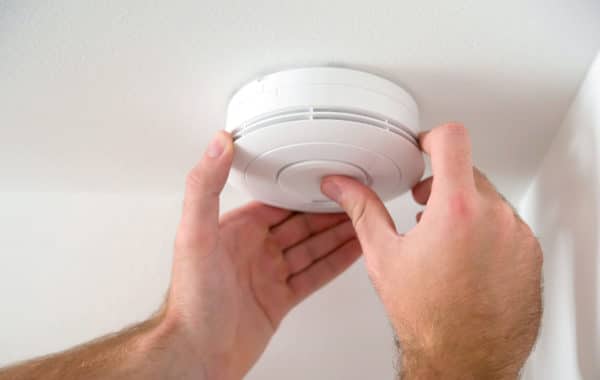Does Your Smoke Detector Detect Carbon Monoxide Gas Too?

Every home in Seattle, Washington is required to have both smoke detectors and carbon monoxide (CO) detectors in place. Whether you’re renting your home or have recently purchased existing construction, it’s important to take stock of these devices and verify their functionality. Some carbon monoxide detectors are separate, standalone units. Others have a handy, combination design that allows them to detect both smoke and CO gas. Following are several tips to help you determine what each device is and does, and how often it needs to be refreshed or replaced.
Placement Is of the Utmost Importance With CO Detectors
Carbon monoxide is a colorless, odorless gas that’s produced by any fuel-burning appliance. Breathing this gas in can cause a number of uncomfortable and incredibly dangerous symptoms to manifest. Also known as carbon monoxide poisoning, CO exposure can result in:
- Fatigue
- Muscle weakness
- Confusion
- Headaches
- Nausea
- Vomiting and other signs of gastric distress
When prolonged, carbon monoxide exposure can also cause people to become unconscious and will eventually result in death.
Unfortunately, although all carbon-monoxide appliances that are installed inside of homes are vented to release CO gas outdoors, most emit negligible amounts of CO gases inside of the living environment. The standard CO detector is actually sensitive enough to pick up on even minute amounts of this gas. As such, you will rarely find either a CO detector or a combination smoke and CO detector installed directly near any CO-producing appliance. Each carbon monoxide detector has its own stated radius for installation in these areas. For instance, many manufacturers suggest installing CO detectors at least nine to 15 feet away from specific appliances on all sides. This installation requirement is intended to prevent false alarms and to keep homeowners from simply removing these safeguards due to annoyance.
Understanding that all fuels produce CO when burned, if you have a device installed right near any fuel-burning appliance, it’s either a smoke detector or a CO detector that’s been improperly put in and must be relocated.
Hard-Wired Smoke Alarms
Many newer Seattle homes have hard-wired smoke alarms. These devices have both batteries and electrical wiring to keep them powered up. If a home’s main electrical supply is disrupted and if no standby generator is in place, the batteries in these units will keep them going.
Hard-wired smoke alarms are found on the ceiling or high up on a home’s walls. Builders typically put these units in bedrooms, in hallways near bedroom entrances, and on ceilings in common areas such as kitchens and living rooms. They can also be in attic areas and garages. There’s rarely any lettering or other visible designations on their covers. Hard-wired smoke detectors have simple, plastic covers and may or may not have visible embossments.
Battery-Powered Smoke Detectors and Where You’ll Find Them
In older buildings, most smoke detectors are entirely battery-powered. Where these units are installed is ultimately up to the knowledge and compliance of the individual property owner. You’ll likely find these units high up on the wall or on the ceilings of hallways and bedrooms. For the sake of preventing false alarms, battery-powered smoke detectors are more likely to be installed in hallways that abut kitchens rather than kitchens themselves.
CO Detectors and Where You’ll Find Them
CO alarms can be anywhere throughout the home. However, when they’re correctly installed, they won’t be too near fuel-burning appliances. You shouldn’t have a CO detector or a combination CO detector and smoke detector near your furnace, gas-powered stove, or gas dryer. These units are required in every hallway and bedroom, or in any hallway that directly abuts a bedroom. Unlike smoke detectors, carbon monoxide detectors are clearly labeled. If you’re uncertain of which detector type is in your hallways, grab a stool, disconnect the device from its mount, and then read the label on its reverse.
Side-by-Side Detectors
If you just bought existing construction and have two detectors that are installed side by side, don’t automatically assume that one of these units is intended to detect CO gas. Although this is most likely the case, there are also times when new smoke detectors are simply installed next to older smoke detectors that are no longer functioning or are obsolete. For the sake of indoor aesthetics and to clear up any confusion, it’s always best to remove non-functioning smoke detectors. The available space can be used to install a standalone CO detector instead.
Low-Wall CO Detectors
Both older and brand new homes in the Seattle area can have low-mounted CO detectors that are installed on the wall just one to two feet away from the floor. These units often have a rectangular shape, and they’re usually clearly labeled on both their front and back sides. The information printed on CO detectors will include their date of manufacture, their expected lifespan, and the best schedules for replacing their batteries.
Combination Smoke Detectors and CO Alarms
There are a number of obvious benefits in having combination smoke and carbon monoxide detectors put in. Foremost among these is that you’ll have far fewer devices to maintain. Combination units take up less space and they also have a far lesser impact on indoor aesthetics.
However, although both CO detectors and smoke detectors should be in individual bedrooms (or right at their entries), and in hallways and other common areas, the correct placement for these units isn’t identical across the board. There are areas of the home where smoke detection may be needed but where the assigned radii for CO detector installation is too small. For instance, if your garage has a fire risk that’s within eight to 10 feet of your furnace, having a smoke detector in this area won’t be ideal. Even having a combination detector put in could lead to annoying false alarms for CO gas.
Locations With Double Requirements
To fulfill the requirements for smoke detection and carbon monoxide detection in hallways and bedrooms, many builders install combination units in these areas that are both hardwired and battery-powered. To confirm that your device is capable of detecting both indoor hazards, look at the markings on its face plate and its reverse side. CO alarms and combination CO alarms are always clearly labeled even though many smoke detectors are not.
Another way to verify whether your devices can detect both CO gas and smoke is by pressing their test buttons. Modern, hard-wired units will issue verbal alerts such as “Warning! Carbon monoxide detected!” or “Warning! Fire detected!”. Combination units will report both warnings in rapid succession when their test buttons are depressed.
After identifying the location and type of detectors in your home, take stock of their replacement dates. You’ll find the necessary information for doing so on their reverse. Making sure that battery-powered models always have fresh, functional batteries is a must. It’s also important to avoid the all-too-common mistake of assuming that hard-wired units are connected to your home’s power supply. In many older homes, battery-powered units are used to replace hard-wired models that have reached the ends of their lifespans, and they’re installed directly over the initial mounts or hard-wire boxes.
Since 1987, Brennan Electric has been proudly serving residents of Seattle, Lynnwood, and Lakewood, Washington. We offer electrical services, lighting installation, and whole-house surge protection. We also provide carbon monoxide and smoke detector installation. If you need help making sure that your Western Washington home is both compliant and protected, give us a call.

